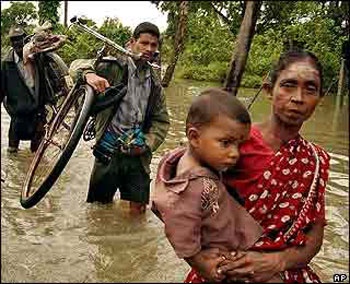Global warming could cause flooding, followed by severe drought in Asia within decades, according to an Aberdeen expert.
If current climate change trends continue it is predicted that the annual summer monsoons which take place throughout Asia would become stronger and stormier, resulting in more catastrophic flooding in South and East Asia. However, the same global warming may also subsequently result in a dramatic and rapid weakening of the summer rains, resulting in critical drought conditions.
Professor Peter Clift, School of Geosciences, University of Aberdeen presents the theory in his recently published book, The Asian Monsoon: Causes, History and Effects.
His suggestions are based on the forecast of many leading experts which warn that if the rapid melting of glaciers in Greenland continues, the North Atlantic, especially North West Europe will get much colder, whilst central Asia will also experience increasingly lower temperatures. As a consequence summer monsoons would become rapidly weaker, leading to a significant drought.
Professor Clift projects that this major period of dry weather could affect central Asia within the next 50 to 200 years.
In his book he notes that although current developments mean that monsoons are likely to become stormier and wetter in years to come, this trend could be abruptly interrupted by a significant period of severe drought.
Professor Clift says: "The current trend we are witnessing in Asian monsoons is that they are becoming more intense in terms of storm and rainfall levels. This can be attributed to the current effects of global warming where we are generally witnessing higher temperatures in the North Atlantic, driving melting of the Greenland icecap. This melting is believed to have caused failure of Gulf Stream circulation in the past, making North West Europe much colder. However, the effects of the Gulf Stream collapse have effects for the climate of Asia too."
"This increased rain and storm activity could have harsh consequences linked to catastrophic weather, rising sea levels and major flooding. Continued global warming is predicted to cause gradually increasing Asian rainfall and storm severity, which have serious consequences for societies living within monsoon affected areas, accounting for two thirds of mankind, and many of the booming "tiger' economies of Asia.
"However predictions based on patterns of monsoons which we can chart through history, suggest that this increased wetter and stormier summer monsoons could rapidly reach a tipping point and be quickly replaced by severely drier weather. Much drier weather and therefore weaker summer monsoons could be experienced within decades, depending on the stability of the Greenland ice cap. This would eventually result in a critical period of mass drought which would have a huge impact in terms of economy and resources for communities in South and East Asia."
In his book Professor Clift also details how major historical events can be attributed to the nature of the monsoons experienced by communities over the past few thousand years. Significant periods of unrest amidst Asian societies often occurred at times when the monsoons rapidly weakened. Famous examples include the collapse of imperial dynasties in China and India.
Professor Clift continues: "Charting monsoons through history, links become obvious as to the effects changes in monsoon strength have had on Asian society. Major events which altered history can be seen to have coincided with certain climatic conditions. For example the Indian mutiny in the 19th century and the Indian independent movement in the early 20th century both occurred at a time when South Asia was experiencing critical drought conditions. Although societal changes have many complicated origins it is clear that the economic stress to society caused by rapid climate change is important in determining whether city states and countries prosper or collapse in revolution and upheaval."
The Asian Monsoon: Causes, History and Effects by Professor Peter D Clift and R Alan Plumb, published by Cambridge is out now.


